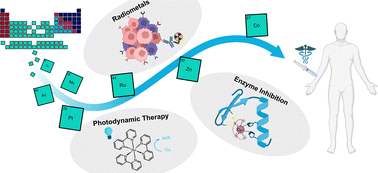Medicinal inorganic chemistry – challenges, opportunities and guidelines to develop the next generation of radioactive, photoactivated and active site inhibiting metal-based medicines†
Abstract
Medicinal inorganic chemistry is a burgeoning subfield of medicinal chemistry that focuses on the development of metal-based diagnostic and therapeutic agents. This tutorial review aims to provide an introductory primer, present a timely overview of recent discoveries and identify current challenges and opportunities of the field. Three specific areas of discovery are highlighted herein. The first part focuses on metal-based radiopharmaceuticals for diagnostic and therapeutic purposes and specific design criteria for the development of radiopharmaceuticals that combine fundamental aqueous coordination chemistry with elucidation of pharmacokinetics. The second part describes approaches to photodynamic therapy with metal complexes. Here, photophysical characterization, combined with the challenge of careful control of the chemical behavior and selective biological deposition of transition metals with significant off-target toxicity, is discussed. In the third part, we summarize emerging strategies to modulate enzyme inhibition with coordination chemistry, while also highlighting the utility of the unique properties of metal ions for the characterization of mechanisms of action of these emerging diagnostic and therapeutic agents.

- This article is part of the themed collection: 2022 Emerging Investigators


 Please wait while we load your content...
Please wait while we load your content...